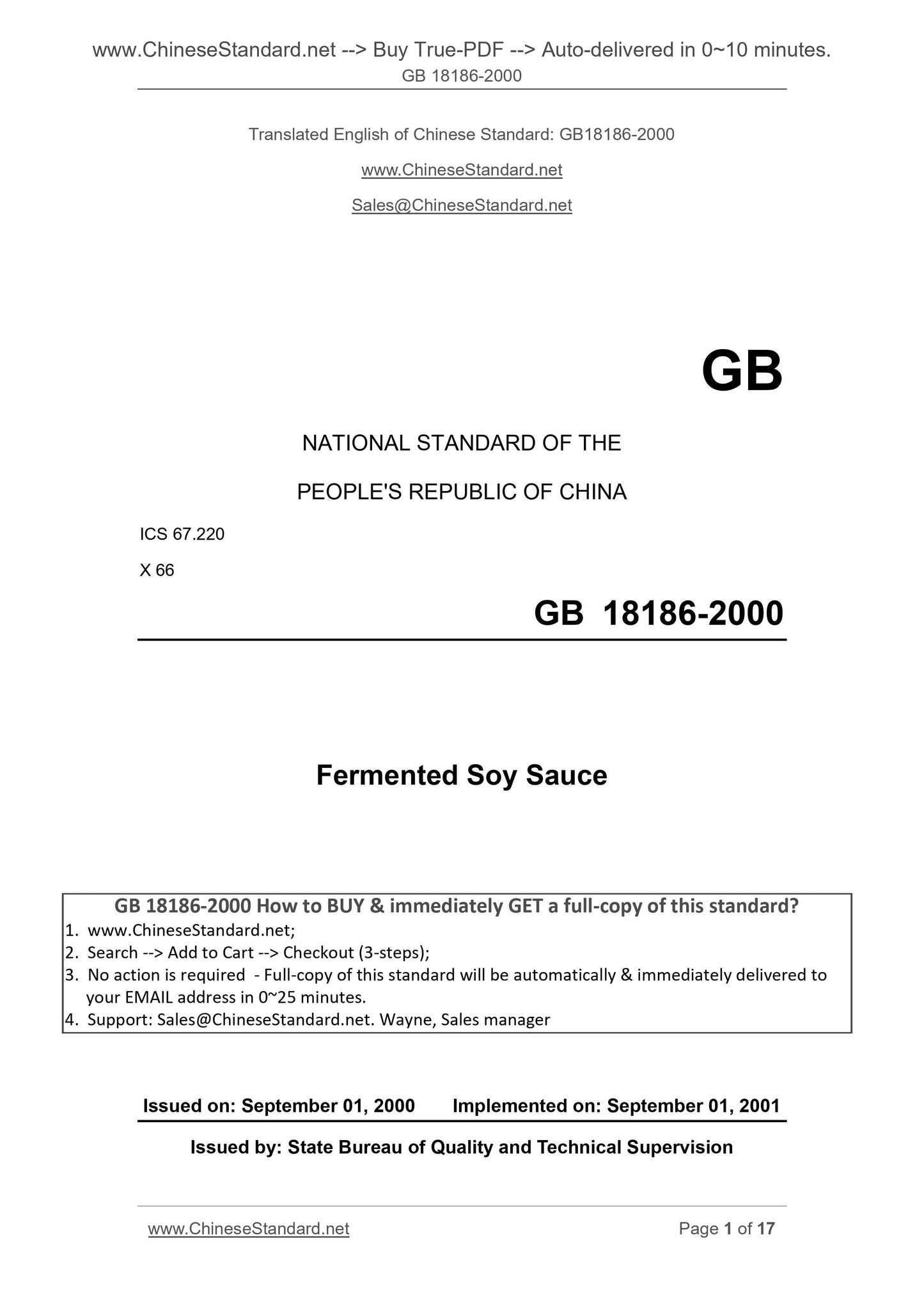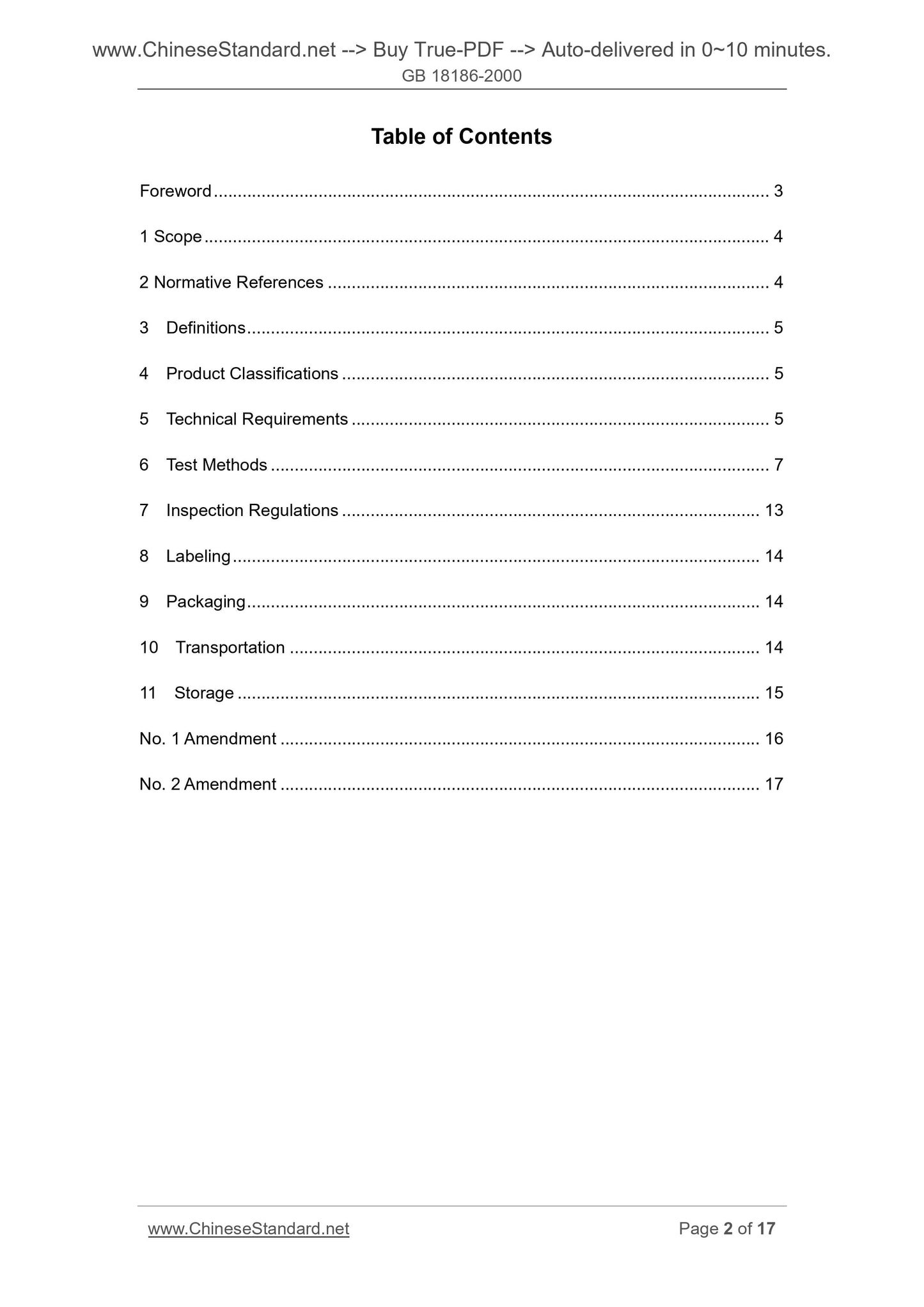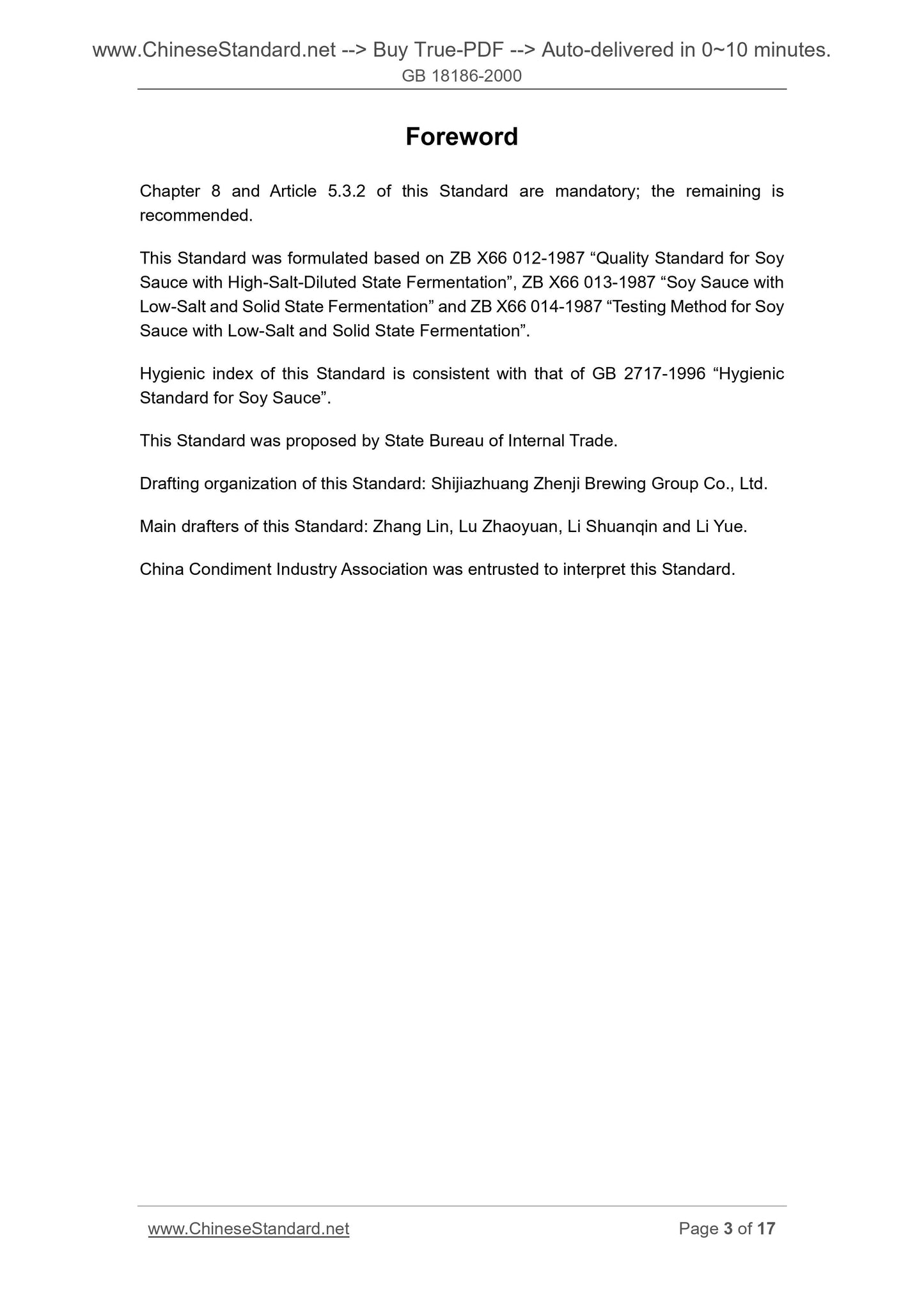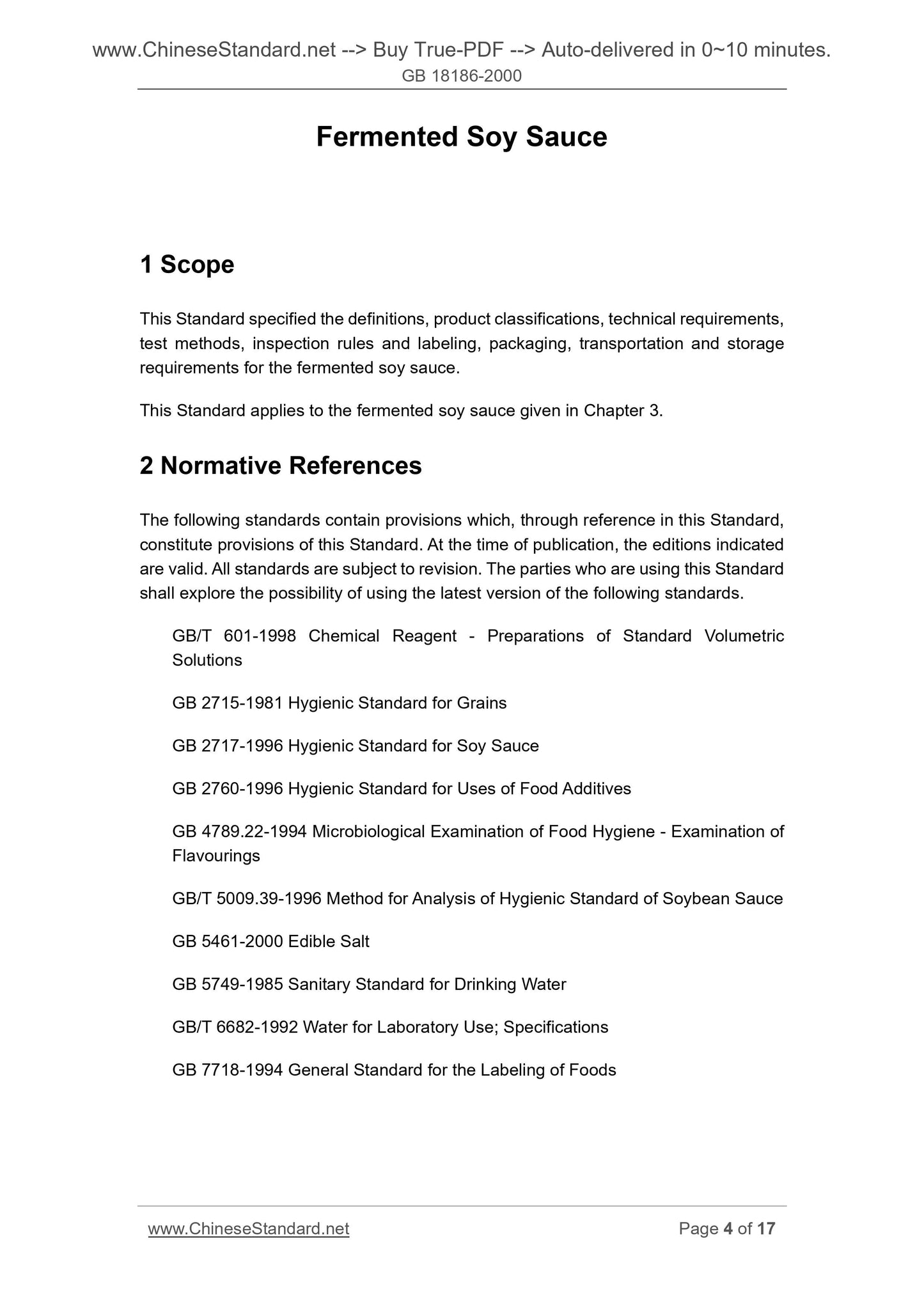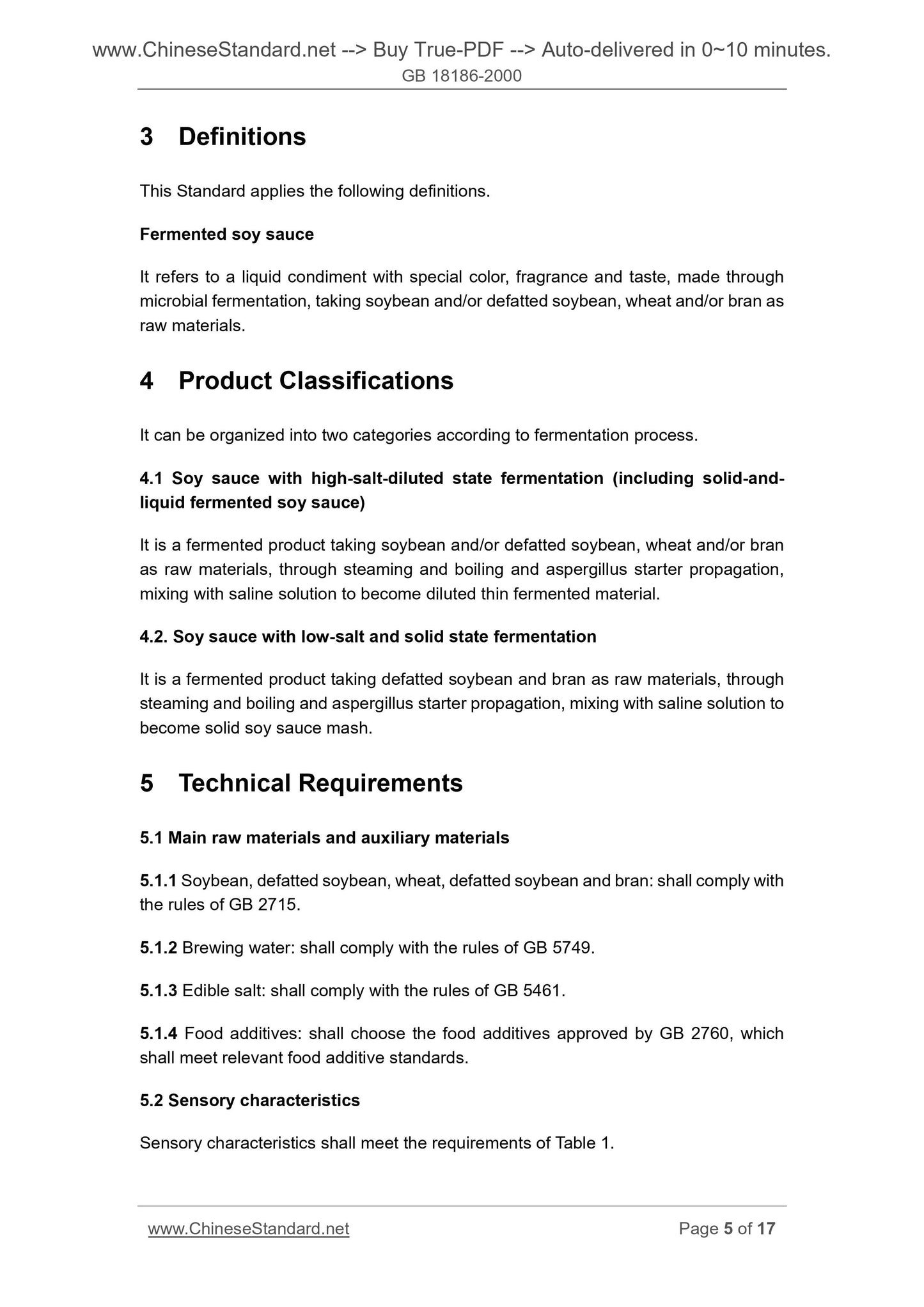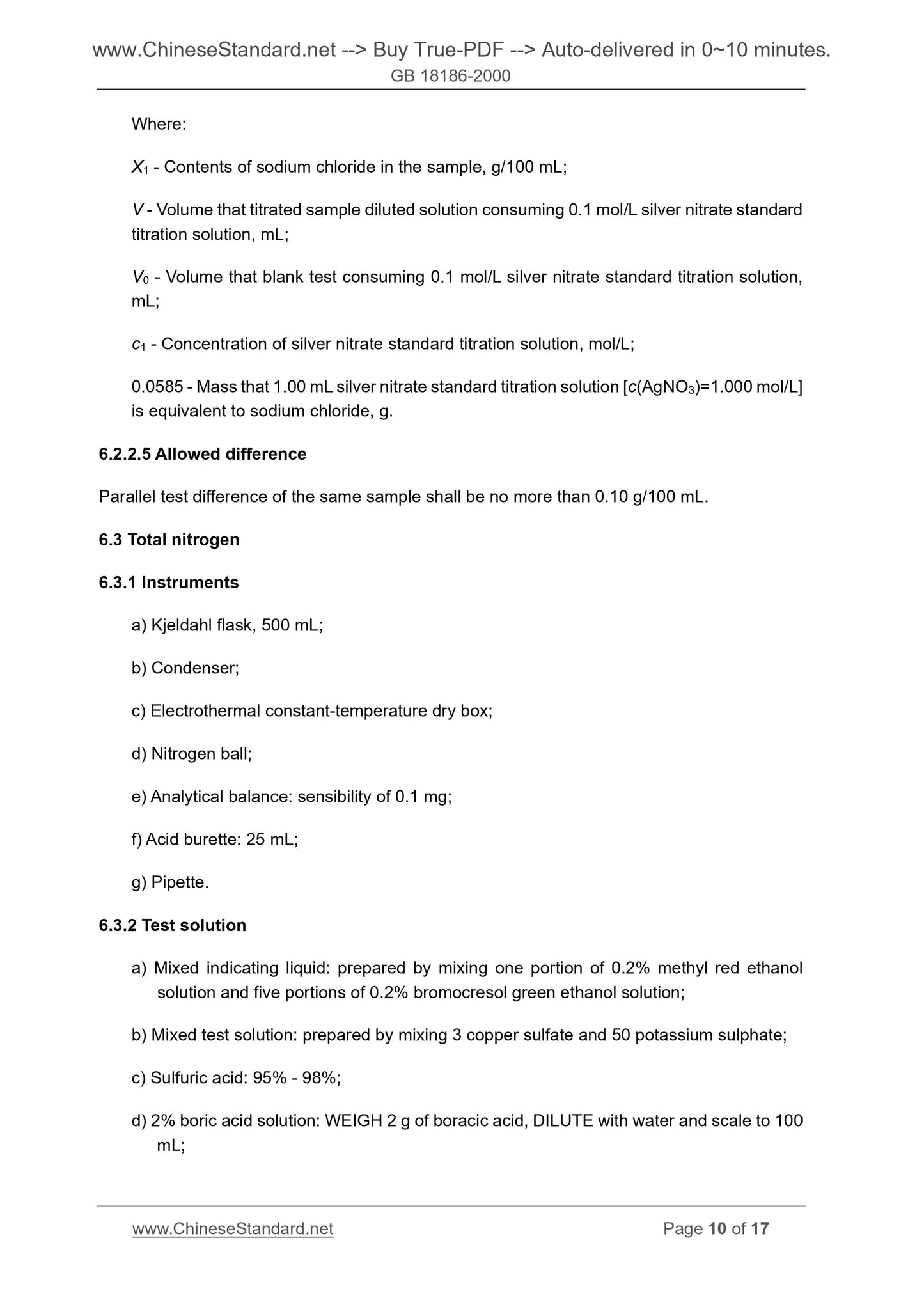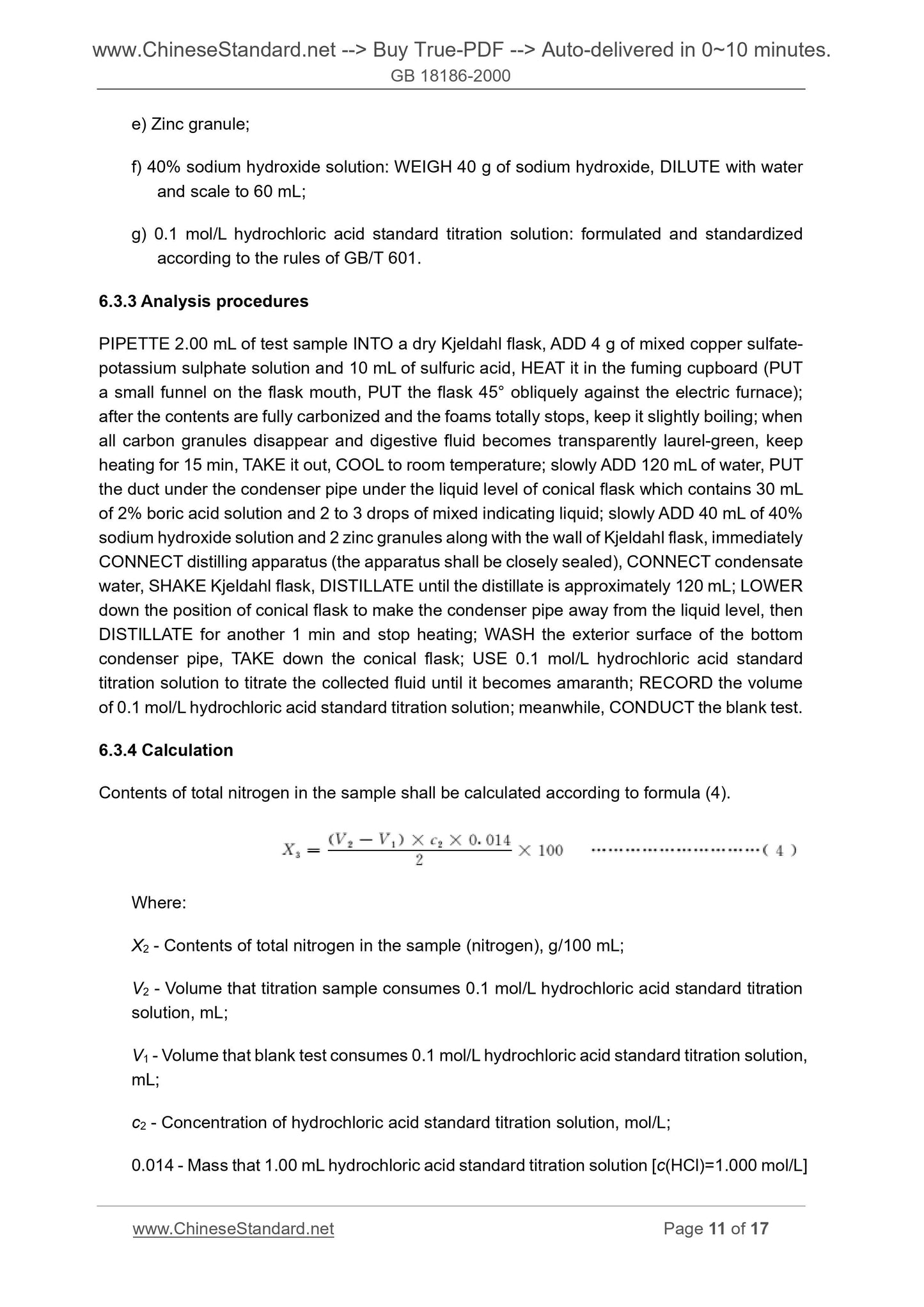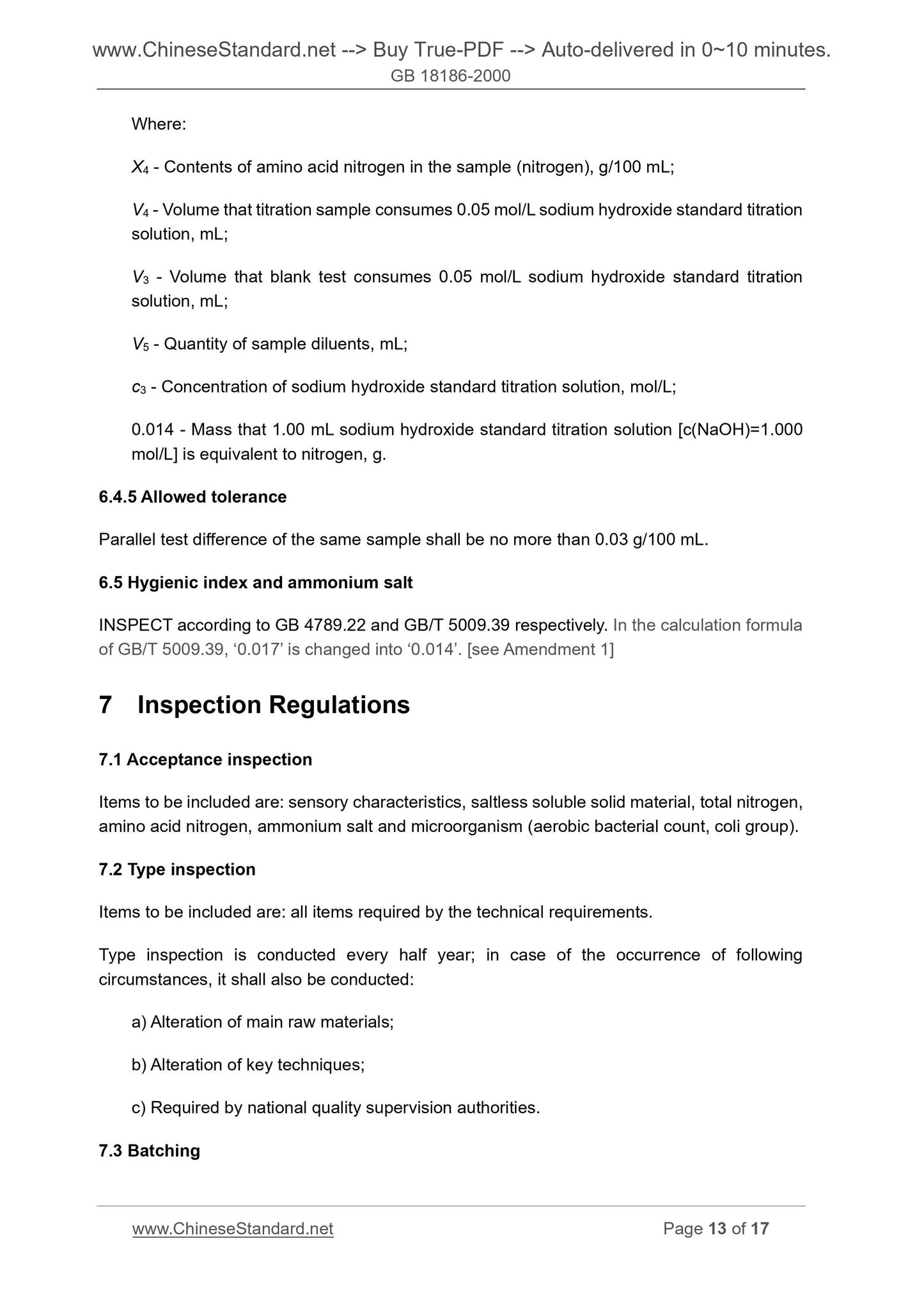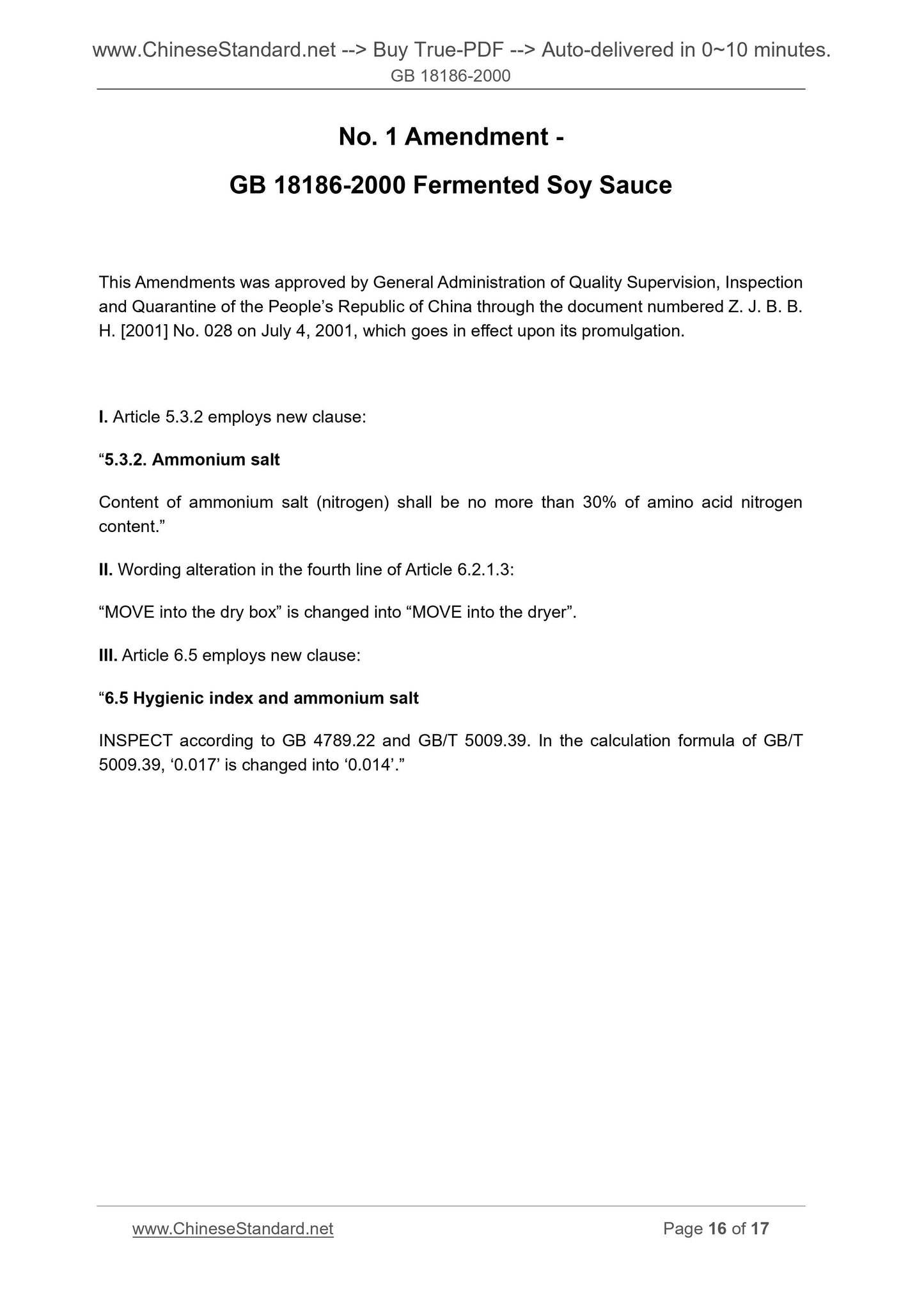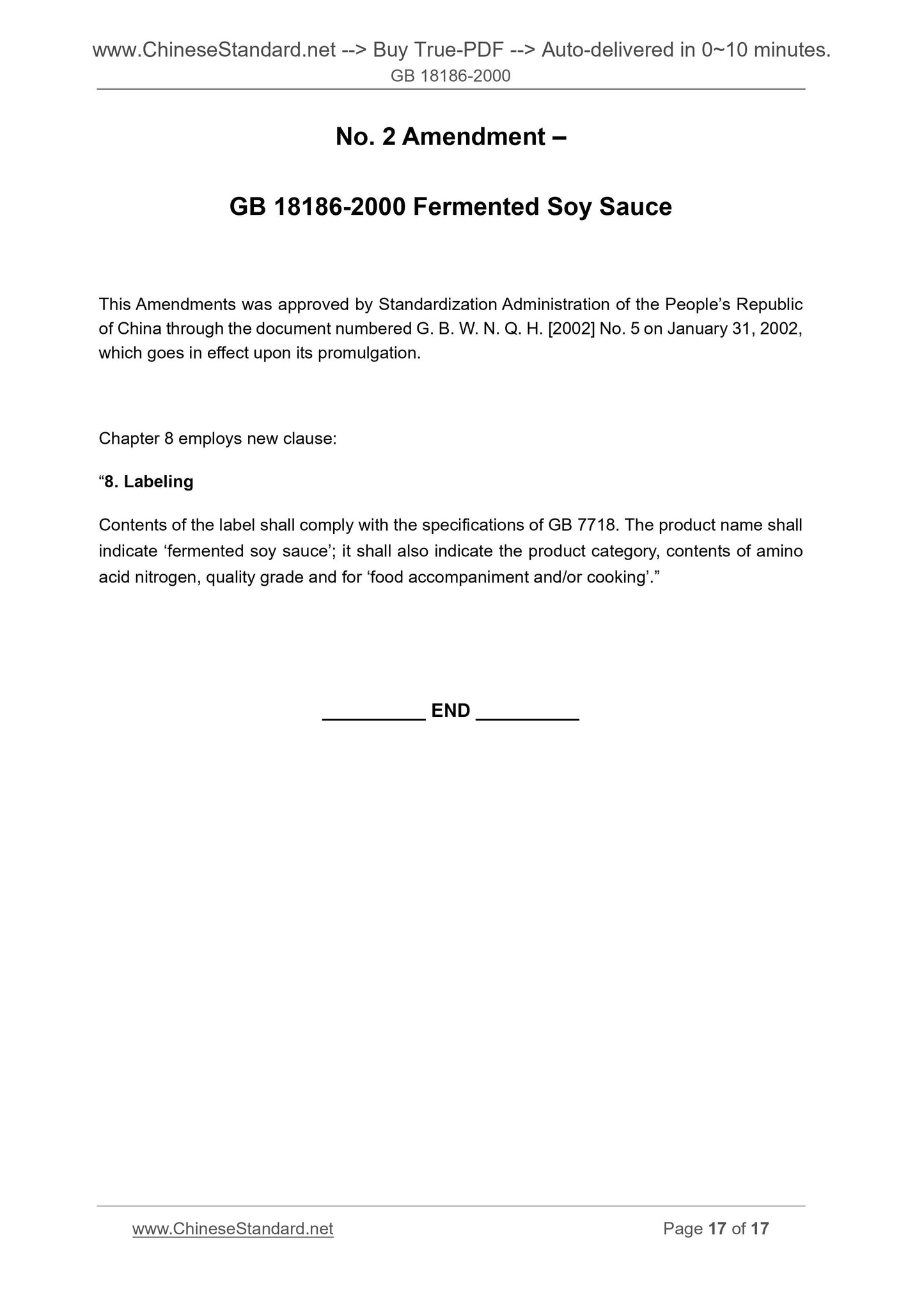1
/
of
10
PayPal, credit cards. Download editable-PDF & invoice in 1 second!
GB 18186-2000 English PDF
GB 18186-2000 English PDF
Regular price
$85.00 USD
Regular price
Sale price
$85.00 USD
Unit price
/
per
Shipping calculated at checkout.
Couldn't load pickup availability
Delivery: 3 seconds. Download true-PDF + Invoice.
Get QUOTATION in 1-minute: Click GB 18186-2000
Historical versions: GB 18186-2000
Preview True-PDF (Reload/Scroll if blank)
GB 18186-2000: [GB/T 18186-2000] Fermented soy sauce [including MODIFICATIONS 1 and 2]
GB 18186-2000
GB
NATIONAL STANDARD OF THE
PEOPLE'S REPUBLIC OF CHINA
ICS 67.220
X 66
Fermented Soy Sauce
酿造酱油
ISSUED ON. SEPTEMBER 01, 2000
IMPLEMENTED ON. SEPTEMBER 01, 2001
Issued by. State Bureau of Quality and Technical Supervision
Table of Contents
Foreword ... 3
1 Scope ... 4
2 Normative References ... 4
3 Definitions ... 5
4 Product Classifications ... 5
5 Technical Requirements ... 5
6 Test Methods ... 7
7 Inspection Regulations ... 13
8 Labeling ... 14
9 Packaging ... 14
10 Transportation ... 14
11 Storage ... 15
No. 1 Amendment ... 16
No. 2 Amendment ... 17
Foreword
Chapter 8 and Article 5.3.2 of this Standard are mandatory; the remaining is
recommended.
This Standard was formulated based on ZB X66 012-1987 “Quality Standard for Soy
Sauce with High-Salt-Diluted State Fermentation”, ZB X66 013-1987 “Soy Sauce with
Low-Salt and Solid State Fermentation” and ZB X66 014-1987 “Testing Method for Soy
Sauce with Low-Salt and Solid State Fermentation”.
Hygienic index of this Standard is consistent with that of GB 2717-1996 “Hygienic
Standard for Soy Sauce”.
This Standard was proposed by State Bureau of Internal Trade.
Drafting organization of this Standard. Shijiazhuang Zhenji Brewing Group Co., Ltd.
Main drafters of this Standard. Zhang Lin, Lu Zhaoyuan, Li Shuanqin and Li Yue.
China Condiment Industry Association was entrusted to interpret this Standard.
Fermented Soy Sauce
1 Scope
This Standard specified the definitions, product classifications, technical requirements,
test methods, inspection rules and labeling, packaging, transportation and storage
requirements for the fermented soy sauce.
This Standard applies to the fermented soy sauce given in Chapter 3.
2 Normative References
The following standards contain provisions which, through reference in this Standard,
constitute provisions of this Standard. At the time of publication, the editions indicated
are valid. All standards are subject to revision. The parties who are using this Standard
shall explore the possibility of using the latest version of the following standards.
GB/T 601-1998 Chemical Reagent - Preparations of Standard Volumetric
Solutions
GB 2715-1981 Hygienic Standard for Grains
GB 2717-1996 Hygienic Standard for Soy Sauce
GB 2760-1996 Hygienic Standard for Uses of Food Additives
GB 4789.22-1994 Microbiological Examination of Food Hygiene - Examination of
Flavourings
GB/T 5009.39-1996 Method for Analysis of Hygienic Standard of Soybean Sauce
GB 5461-2000 Edible Salt
GB 5749-1985 Sanitary Standard for Drinking Water
GB/T 6682-1992 Water for Laboratory Use; Specifications
GB 7718-1994 General Standard for the Labeling of Foods
3 Definitions
This Standard applies the following definitions.
Fermented soy sauce
It refers to a liquid condiment with special color, fragrance and taste, made through
microbial fermentation, taking soybean and/or defatted soybean, wheat and/or bran as
raw materials.
4 Product Classifications
It can be organized into two categories according to fermentation process.
4.1 Soy sauce with high-salt-diluted state fermentation (including solid-and-
liquid fermented soy sauce)
It is a fermented product taking soybean and/or defatted soybean, wheat and/or bran
as raw materials, through steaming and boiling and aspergillus starter propagation,
mixing with saline solution to become diluted thin fermented material.
4.2. Soy sauce with low-salt and solid state fermentation
It is a fermented product taking defatted soybean and bran as raw materials, through
steaming and boiling and aspergillus starter propagation, mixing with saline solution to
become solid soy sauce mash.
5 Technical Requirements
5.1 Main raw materials and auxiliary materials
5.1.1 Soybean, defatted soybean, wheat, defatted soybean and bran. shall comply with
the rules of GB 2715.
5.1.2 Brewing water. shall comply with the rules of GB 5749.
5.1.3 Edible salt. shall comply with the rules of GB 5461.
5.1.4 Food additives. shall choose the food additives approved by GB 2760, which
shall meet relevant food additive standards.
5.2 Sensory characteristics
Sensory characteristics shall meet the requirements of Table 1.
Where.
X1 - Contents of sodium chloride in the sample, g/100 mL;
V - Volume that titrated sample diluted solution consuming 0.1 mol/L silver nitrate standard
titration solution, mL;
V0 - Volume that blank test consuming 0.1 mol/L silver nitrate standard titration solution,
mL;
c1 - Concentration of silver nitrate standard titration solution, mol/L;
0.0585 - Mass that 1.00 mL silver nitrate standard titration solution [c(AgNO3)=1.000 mol/L]
is equivalent to sodium chloride, g.
6.2.2.5 Allowed difference
Parallel test difference of the same sample shall be no more than 0.10 g/100 mL.
6.3 Total nitrogen
6.3.1 Instruments
a) Kjeldahl flask, 500 mL;
b) Condenser;
c) Electrothermal constant-temperature dry box;
d) Nitrogen ball;
e) Analytical balance. sensibility of 0.1 mg;
f) Acid burette. 25 mL;
g) Pipette.
6.3.2 Test solution
a) Mixed indicating liquid. prepared by mixing one portion of 0.2% methyl red ethanol
solution and five portions of 0.2% bromocresol green ethanol solution;
b) Mixed test solution. prepared by mixing 3 copper sulfate and 50 potassium sulphate;
c) Sulfuric acid. 95% - 98%;
d) 2% boric acid solution. WEIGH 2 g of boracic acid, DILUTE with water and scale to 100
mL;
e) Zinc granule;
f) 40% sodium hydroxide solution. WEIGH 40 g of sodium hydroxide, DILUTE with water
and scale to 60 mL;
g) 0.1 mol/L hydrochloric acid standard titration solution. formulated and standardized
according to the rules of GB/T 601.
6.3.3 Analysis procedures
PIPETTE 2.00 mL of test sample INTO a dry Kjeldahl flask, ADD 4 g of mixed copper sulfate-
potassium sulphate solution and 10 mL of sulfuric acid, HEAT it in the fuming cupboard (PUT
a small funnel on the flask mouth, PUT the flask 45° obliquely against the electric furnace);
after the contents are fully carbonized and the foams totally stops, keep it slightly boiling; when
all carbon granules disappear and digestive fluid becomes transparently laurel-green, keep
heating for 15 min, TAKE it out, COOL to room temperature; slowly ADD 120 mL of water, PUT
the duct under the condenser pipe under the liquid level of conical flask which contains 30 mL
of 2% boric acid solution and 2 to 3 drops of mixed indicating liquid; slowly ADD 40 mL of 40%
sodium hydroxide solution and 2 zinc granules along with the wall of Kjeldahl flask, immediately
CONNECT distilling apparatus (the apparatus shall be closely sealed), CONNECT condensate
water, SHAKE Kjeldahl flask, DISTILLATE until the distillate is approximately 120 mL; LOWER
down the position of conical flask to make the condenser pipe away from the liquid level, then
DISTILLATE for another 1 min and stop heating; WASH the exterior surface of the bottom
condenser pipe, TAKE down the conical flask; USE 0.1 mol/L hydrochloric acid standard
titration solution to titrate the collected fluid until it becomes amaranth; RECORD the volume
of 0.1 mol/L hydrochloric acid standard titration solution; meanwhile, CONDUCT the blank test.
6.3.4 Calculation
Contents of total nitrogen in the sample shall be calculated according to formula (4).
Where.
X2 - Contents of total nitrogen in the sample (nitrogen), g/100 mL;
...
Get QUOTATION in 1-minute: Click GB 18186-2000
Historical versions: GB 18186-2000
Preview True-PDF (Reload/Scroll if blank)
GB 18186-2000: [GB/T 18186-2000] Fermented soy sauce [including MODIFICATIONS 1 and 2]
GB 18186-2000
GB
NATIONAL STANDARD OF THE
PEOPLE'S REPUBLIC OF CHINA
ICS 67.220
X 66
Fermented Soy Sauce
酿造酱油
ISSUED ON. SEPTEMBER 01, 2000
IMPLEMENTED ON. SEPTEMBER 01, 2001
Issued by. State Bureau of Quality and Technical Supervision
Table of Contents
Foreword ... 3
1 Scope ... 4
2 Normative References ... 4
3 Definitions ... 5
4 Product Classifications ... 5
5 Technical Requirements ... 5
6 Test Methods ... 7
7 Inspection Regulations ... 13
8 Labeling ... 14
9 Packaging ... 14
10 Transportation ... 14
11 Storage ... 15
No. 1 Amendment ... 16
No. 2 Amendment ... 17
Foreword
Chapter 8 and Article 5.3.2 of this Standard are mandatory; the remaining is
recommended.
This Standard was formulated based on ZB X66 012-1987 “Quality Standard for Soy
Sauce with High-Salt-Diluted State Fermentation”, ZB X66 013-1987 “Soy Sauce with
Low-Salt and Solid State Fermentation” and ZB X66 014-1987 “Testing Method for Soy
Sauce with Low-Salt and Solid State Fermentation”.
Hygienic index of this Standard is consistent with that of GB 2717-1996 “Hygienic
Standard for Soy Sauce”.
This Standard was proposed by State Bureau of Internal Trade.
Drafting organization of this Standard. Shijiazhuang Zhenji Brewing Group Co., Ltd.
Main drafters of this Standard. Zhang Lin, Lu Zhaoyuan, Li Shuanqin and Li Yue.
China Condiment Industry Association was entrusted to interpret this Standard.
Fermented Soy Sauce
1 Scope
This Standard specified the definitions, product classifications, technical requirements,
test methods, inspection rules and labeling, packaging, transportation and storage
requirements for the fermented soy sauce.
This Standard applies to the fermented soy sauce given in Chapter 3.
2 Normative References
The following standards contain provisions which, through reference in this Standard,
constitute provisions of this Standard. At the time of publication, the editions indicated
are valid. All standards are subject to revision. The parties who are using this Standard
shall explore the possibility of using the latest version of the following standards.
GB/T 601-1998 Chemical Reagent - Preparations of Standard Volumetric
Solutions
GB 2715-1981 Hygienic Standard for Grains
GB 2717-1996 Hygienic Standard for Soy Sauce
GB 2760-1996 Hygienic Standard for Uses of Food Additives
GB 4789.22-1994 Microbiological Examination of Food Hygiene - Examination of
Flavourings
GB/T 5009.39-1996 Method for Analysis of Hygienic Standard of Soybean Sauce
GB 5461-2000 Edible Salt
GB 5749-1985 Sanitary Standard for Drinking Water
GB/T 6682-1992 Water for Laboratory Use; Specifications
GB 7718-1994 General Standard for the Labeling of Foods
3 Definitions
This Standard applies the following definitions.
Fermented soy sauce
It refers to a liquid condiment with special color, fragrance and taste, made through
microbial fermentation, taking soybean and/or defatted soybean, wheat and/or bran as
raw materials.
4 Product Classifications
It can be organized into two categories according to fermentation process.
4.1 Soy sauce with high-salt-diluted state fermentation (including solid-and-
liquid fermented soy sauce)
It is a fermented product taking soybean and/or defatted soybean, wheat and/or bran
as raw materials, through steaming and boiling and aspergillus starter propagation,
mixing with saline solution to become diluted thin fermented material.
4.2. Soy sauce with low-salt and solid state fermentation
It is a fermented product taking defatted soybean and bran as raw materials, through
steaming and boiling and aspergillus starter propagation, mixing with saline solution to
become solid soy sauce mash.
5 Technical Requirements
5.1 Main raw materials and auxiliary materials
5.1.1 Soybean, defatted soybean, wheat, defatted soybean and bran. shall comply with
the rules of GB 2715.
5.1.2 Brewing water. shall comply with the rules of GB 5749.
5.1.3 Edible salt. shall comply with the rules of GB 5461.
5.1.4 Food additives. shall choose the food additives approved by GB 2760, which
shall meet relevant food additive standards.
5.2 Sensory characteristics
Sensory characteristics shall meet the requirements of Table 1.
Where.
X1 - Contents of sodium chloride in the sample, g/100 mL;
V - Volume that titrated sample diluted solution consuming 0.1 mol/L silver nitrate standard
titration solution, mL;
V0 - Volume that blank test consuming 0.1 mol/L silver nitrate standard titration solution,
mL;
c1 - Concentration of silver nitrate standard titration solution, mol/L;
0.0585 - Mass that 1.00 mL silver nitrate standard titration solution [c(AgNO3)=1.000 mol/L]
is equivalent to sodium chloride, g.
6.2.2.5 Allowed difference
Parallel test difference of the same sample shall be no more than 0.10 g/100 mL.
6.3 Total nitrogen
6.3.1 Instruments
a) Kjeldahl flask, 500 mL;
b) Condenser;
c) Electrothermal constant-temperature dry box;
d) Nitrogen ball;
e) Analytical balance. sensibility of 0.1 mg;
f) Acid burette. 25 mL;
g) Pipette.
6.3.2 Test solution
a) Mixed indicating liquid. prepared by mixing one portion of 0.2% methyl red ethanol
solution and five portions of 0.2% bromocresol green ethanol solution;
b) Mixed test solution. prepared by mixing 3 copper sulfate and 50 potassium sulphate;
c) Sulfuric acid. 95% - 98%;
d) 2% boric acid solution. WEIGH 2 g of boracic acid, DILUTE with water and scale to 100
mL;
e) Zinc granule;
f) 40% sodium hydroxide solution. WEIGH 40 g of sodium hydroxide, DILUTE with water
and scale to 60 mL;
g) 0.1 mol/L hydrochloric acid standard titration solution. formulated and standardized
according to the rules of GB/T 601.
6.3.3 Analysis procedures
PIPETTE 2.00 mL of test sample INTO a dry Kjeldahl flask, ADD 4 g of mixed copper sulfate-
potassium sulphate solution and 10 mL of sulfuric acid, HEAT it in the fuming cupboard (PUT
a small funnel on the flask mouth, PUT the flask 45° obliquely against the electric furnace);
after the contents are fully carbonized and the foams totally stops, keep it slightly boiling; when
all carbon granules disappear and digestive fluid becomes transparently laurel-green, keep
heating for 15 min, TAKE it out, COOL to room temperature; slowly ADD 120 mL of water, PUT
the duct under the condenser pipe under the liquid level of conical flask which contains 30 mL
of 2% boric acid solution and 2 to 3 drops of mixed indicating liquid; slowly ADD 40 mL of 40%
sodium hydroxide solution and 2 zinc granules along with the wall of Kjeldahl flask, immediately
CONNECT distilling apparatus (the apparatus shall be closely sealed), CONNECT condensate
water, SHAKE Kjeldahl flask, DISTILLATE until the distillate is approximately 120 mL; LOWER
down the position of conical flask to make the condenser pipe away from the liquid level, then
DISTILLATE for another 1 min and stop heating; WASH the exterior surface of the bottom
condenser pipe, TAKE down the conical flask; USE 0.1 mol/L hydrochloric acid standard
titration solution to titrate the collected fluid until it becomes amaranth; RECORD the volume
of 0.1 mol/L hydrochloric acid standard titration solution; meanwhile, CONDUCT the blank test.
6.3.4 Calculation
Contents of total nitrogen in the sample shall be calculated according to formula (4).
Where.
X2 - Contents of total nitrogen in the sample (nitrogen), g/100 mL;
...
Share
